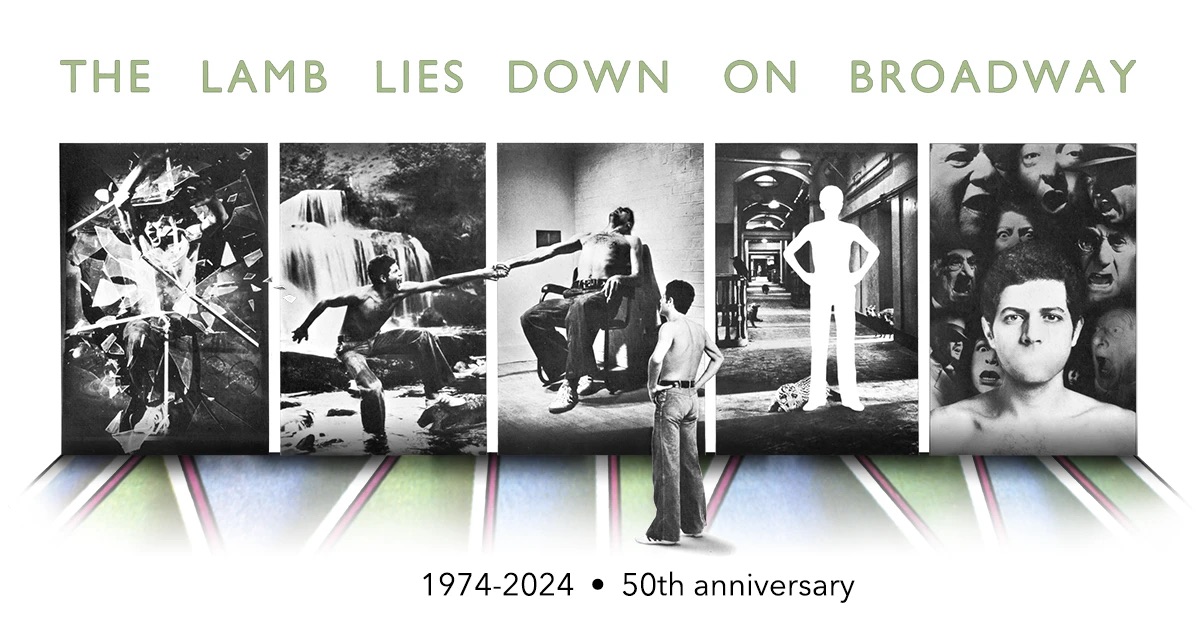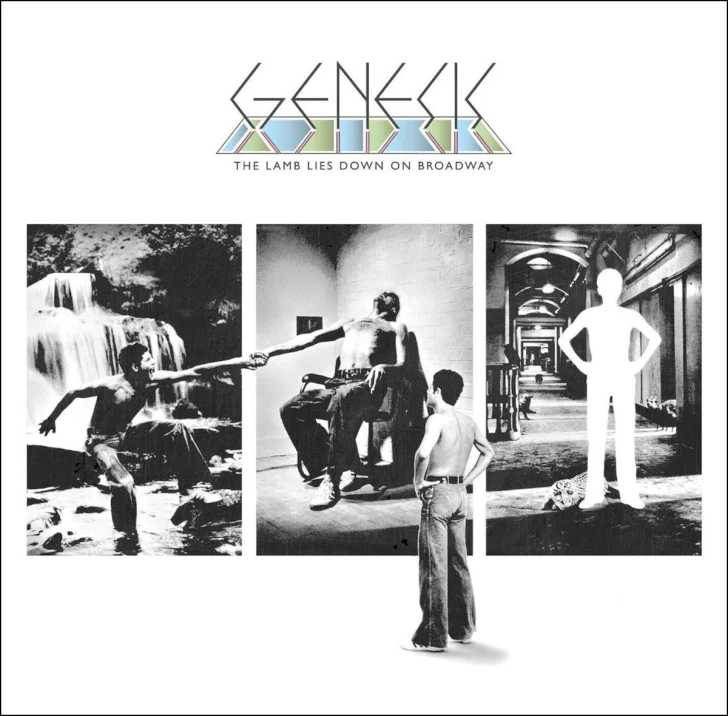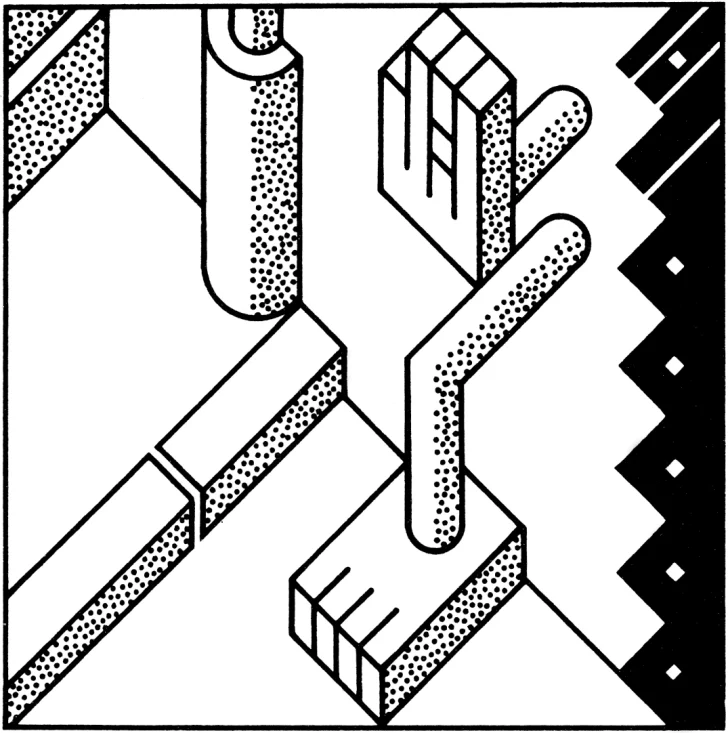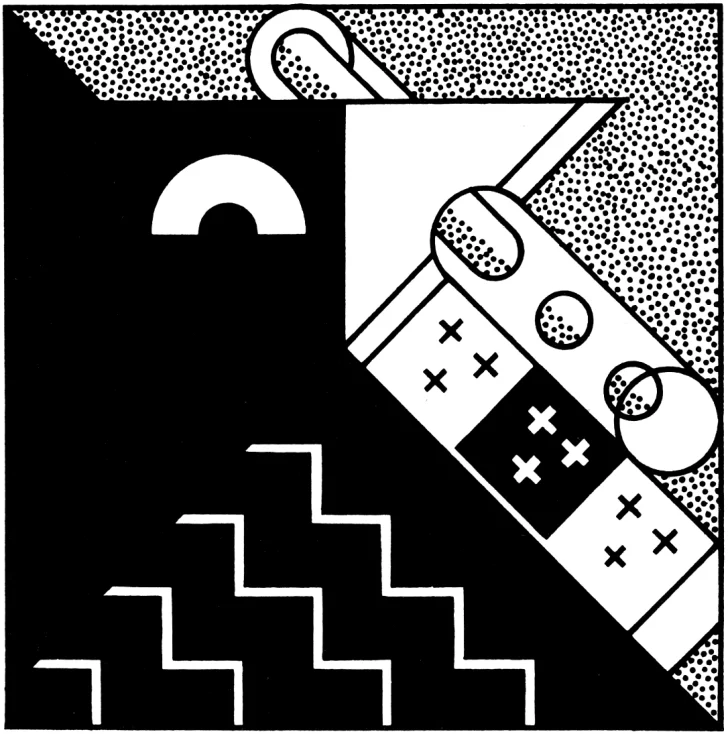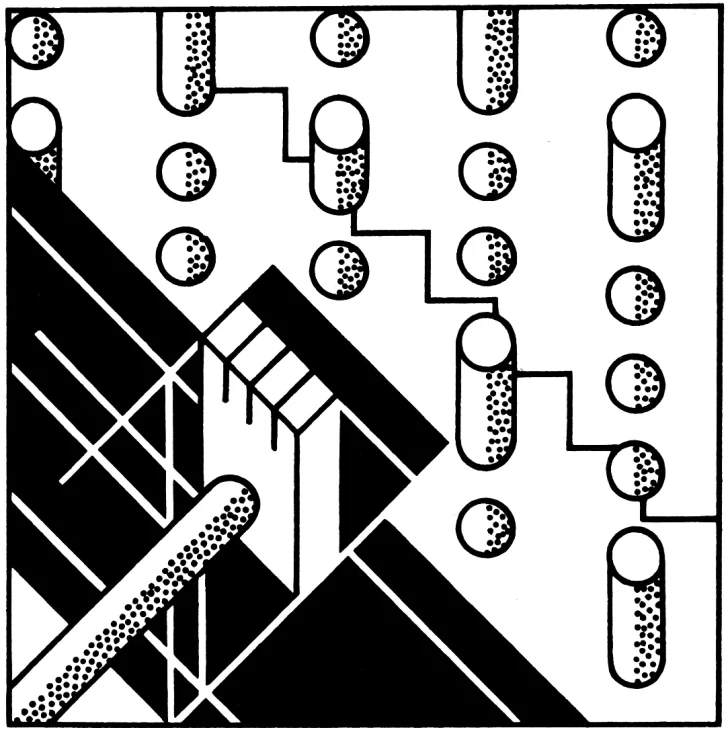- Article
- Read in 23 minutes
Genesis – The Lamb Lies Down On Broadway – album review
After their Top Ten success in 1973 Genesis went on to produce their most ambitious work in 1974 – a production that brought out big rifts in the band.
When Genesis finished their Selling England tour with a performance at the Academy Of Music in New York in early May 1974 they had come a long way. In the three years before that date Genesis had been touring almost continuously playing more than 400 shows – that is one gig every three days on average. After releasing not only a studio album called Selling England By The Pound but also a live record the quintet took a break from touring to write and record their next album.
Work on their previous albums had always consisted of picking from all the material they had tried out those bits and pieces they liked best in a more or less democratic process. They often had to put songs to the vote because the record was full already. The vote for/against one song on Selling England had come out a draw; as a consequence all songs ended on the record that did not sound very good anymore because of the technical limitations of the vinyl record [as Tony explains in Chapter & Verse, p. 148].
Genesis drew their own conclusions from that and set out to make the new album a double album right from the start. The decision gave them enough space to extend the songs but it also meant that they had to write almost twice as much material good enough to be published. And this amount of music had to have a corresponding amount of lyrics to go with it. Peter Gabriel demanded that part for himself, which was unprecedented and unlike the way the band used to work before. On the other hand he was, after all, the author of the bizarre stories he would tell between songs during a concert and also of the surreal anecdote about the lady in the tube train that decorated the back of their Live album. There was no doubt that he would bring enough creativity to bear on this job. From the large amount of lyrics written by one person it was just a small step to the idea that these lyrics would tell a continuous story. A double album where all the songs tell one story – suddenly it was not a simple album Genesis were working on anymore, but the hallmark of every prog rock group, the concept album.
The concept album
A concept album is an record on which all songs are linked by a common theme. According to the closer definition the link consists in the songs telling a continuous story; since that is also a criterion for the opera in classical music concept albums, and their live performance in particular, are occasionally and quite aptly labeled “rock operas”.
A record is a concept album in a broader sense when all songs are loosely connected by a common topic or mood; this also applies to the song cycle so the one is difficult to distinguish from the other. Though they are by no means restricted to that type of music concept albums are frequently recorded in the progressive rock genre, perhaps because the presentation of a continuous story fulfills the artist’s demand for intellectual and musical challenge. By the mid-70s concept albums were a new idea anymore. Pet Sounds (1966) by The Beach Boys and Sgt Pepper’s Lonely Hearts Club Band (1967) by The Beatles are usually considered the earliest concept albums.
Now they needed a story for it. They discussed a number of candidates and dismissed them again. In the end Peter’s idea to write a whole new story for the album won over Mike Rutherford’s suggestion to set Antoine de Saint-Exupéry’s fairy-tale The Little Prince.
Creating a classic
Right after the end of their Selling England tour Genesis rented Headley Grange, an old mansion and poorhouse in Hampshire southwest of London. The place was not unknown in the history of music: Led Zeppelin had recorded parts of Led Zeppelin IV in it – and curiously enough, Jimmy Page has a supernatural experience there quite similar to the one Peter mentioned as his inspiration for the first part of Supper’s Ready. The band arrived there in mid-May and instantly started – cleaning. The previous tenants had apparently had a rather distanced relationship to cleanliness and hygiene. Tony Banks remembers human feces in a room that was not the bathroom, and Peter Gabriel remembers that all the rats appeared very curious what they new two-legged creatures were up to in their territory.
To speed up the writing of the new album Peter sat in one corner of the house working on the lyrics while the others wrote new music. Before that, however, the general gist of the storyline had to be finished.

“I’ve always thought it amazing that The Lamb, an album with such an urban atmosphere and more ‘American’ sounding than either the predecessor or the successor, was written at an old, rat-infested mansion in rural southern England, and recorded in a remote village in rural Wales. You can’t get further away from Manhattan in many ways.” (a fan)
Its protagonist is a young Puerto Rican in New York who is one morning swallowed by a huge black wall, undergoes a series of surreal experiences and finally rescues from a roaring river his brother – or himself? The story of Rael has many levels on which it can be read and understood, it is full of allusions and puns; it is as open to lots of interpretations as it seems to deny the one definitive interpretation. What makes this story so magical may be precisely the fact that the listener can always decode it afresh and differently. Since its release – which other band, which other album could claim this? – a large and growing community of fans has developed who enjoy discussing interpretations of the album almost as much as the album itself.
Much has been put into it and read out of it: Some claim it is Peter Gabriel’s roman à clef, that he (as Rael) debated leaving Genesis with his alter ego (Brother John). Other read it as a modern-day version of King Lear and point out that Rael spelt backwards reads Lear – every new point of view discloses new facets of a remarkable story.
One adjective is frequently used to describe the story of Rael: Unwieldy – a story hard to get into. There is indeed a rupture between Selling England and The Lamb both in style and content that forces the reader-listener to find their bearings again – in two ways because the changes in style and content are chiastic. While the story of The Lamb became even more fantastic and bizarre than the previous albums, the tone of the narrative became much more sober. Therefore, the statement that The Lamb was “Genesis’ most American album to date” cannot be dismissed out of hand.
became even more fantastic and bizarre than the lyrics on previous records the tone of the narration sobered up. There is therefore some truth to the claim that
Is it a coincidence that Gabriel sets the story – a story of loss and regain – in New York where the band had played the last two shows of the Selling England tour – and where the final show had to be postponed for a day because someone had stolen their guitars? Probably yes, but who can say for sure with a band who draw inspiration from the Labour Party’s election programme and Ovid’s Metamorphoses alike? The starting point for the mood of the story was Leonard Bernstein’s famous musical West Side Story. Apart from that the story of Rael “indirectly” describes “lots of my emotional experiences”, as Gabriel once explained [Hugh Fielder, The Book Of Genesis, p.90]. Gabriel also drew parallels between Rael’s journey and Pilgrim’s Progress (John Bunyan’s allegory The Pilgrim’s Progress tells the way of the faithful Christian through all of life’s hardships to the heavenly Jerusalem). Whether there are parallels in the context apart from the common theme of both texts cannot be discussed at this point.
While Tony, Mike, Steve and Phil were busy writing music for the new album, Peter was writing the lyrics. Soon the music had progressed further than the lyrics which was because Peter had other things on his mind: His wife Jill had a troubled pregnancy. Gabriel drove to London as often as he could to be with her. His unfinished work caused tensions in the band and made Gabriel pass some of the songs to the others so they could write the lyrics for it.
In the middle of the writing process the project threatened to die. Director William Friedkin wanted to have Peter Gabriel as a creative mind for various projects; his fellow band members did not want to let him go. Gabriel left the band briefly. Differing reasons were given for his return: Friedkin’s desire not to break up the band, a reprimand by Mike “not to be silly” or an insistent intervention by Genesis’ then manager Tony Stratton-Smith.
At the end of July the band’s lease of Headley Grange ran out. The band, however, had not yet recorded a single note and began to look for another place to record the album. They found it in Wales, on a small farm called Glaspant (frequently misspelled Glossplant, 50km NW of Swansea). There they recorded The Lamb Lies Down On Broadway
with the Manor Mobile Studio. The album was mixed at Island studios, London, until mid-October, and released on November 22, 1974 [see separate artivle about the release date here].
At the same time Genesis prepared for the Lamb Lies Down On Broadway tour which, as the album itself, was hampered by delays: Steve Hackett cut his hand and they played the first Lamb shows in the United States – before the album had even been released there. But the tour is a chapter of its own…
The Lamb Lies Down On Broadway was originally released as a double LP. When compact discs appeared in the mid-80s The Lamb was re-released on 2CD; this was the so-called “greybox” or “greyframe” version. It took its name from the grey frame that had been put around a part of the original cover, and, like the whole series, it did not sound too good. Quite an improvement was established by the release of the Definitive Edition Remaster in the late 90s. On both CD versions the cuts between the individual pieces were a bit peculiar: Though the booklets list the full lyrics for the song, The Broadway Melody Of 1974 consists only of the 33 instrumental seconds that form the transition to Cuckoo Cocoon.
The reviewer looks very much forward to the re-release of The Lamb as part of the so-called “third boxset” which is scheduled to be released in November 2008.
These three main CD versions (and most special pressings in individual countries) use the famous Hipgnosis cover of the original LP version; they frequently also use design elements of the original lyrics sheets that came with the records: black and white ornaments and almost cubistic, simplified illustrations (usually in a square format) as well as a single photo. Incidentally, it took the reviewer years to realize that Rael is visible in and behind all those glass shards. Apart from the lyrics the booklets and lyric sheets usually also offer the Story Of Rael, which offers the general gist of the story, confused though it may be, and is actually a narrative treat. It shows just how much fun Gabriel had in placing all the allusions and puns all over story and lyrics.

The Music
The swan song of Genesis as the classic quintet begins with a tinkling piano intro from Tony. With a mighty chord the rest of the band joins him, like an image of the softly rippling sea that is suddenly and seamlessly replaced by the concrete towers of Manhattan. The title song rocks steadily ahead while Gabriel tells how Rael stumbles between the other night owls from out of the subway into an awakening New York. Then the noise of the city fades behind the all-devouring wall of death. Fly On A Windshield uses ethereal and acoustic sounds to give an impression of the wind blowing through the urban canyons before it depicts Rael hitting the strange wall at full speed. The Broadway Melody Of 1974 brings back yesterdays stars from Broadway, Hollywood and sundry scandals in a parade-like rhythm. The frequency with which the lyrics allude to certain people or things is evidently at a maximum here; nowhere else than here are they as easily decoded. The pageant of celebrities results from the allusion in the song’s title: In the decade before World War II there were no less than four films called Broadway Melody Of …(1929, 1936, 1938 and 1940) in which more and more stars could be seen.
What the people in charge found evidently much harder was determining the border between Fly On A Windshield and the Broadway Melody Of 1974: Both CD releases differ from each other and probably also from the correct border. The reviewer feels that the Broadway Melody begins right before the line “Echoes of the Broadway Everglades” which at least fits the distribution of lyrics in the booklet. Peter Gabriel sings in all kinds of voices depending on whether he is impersonating film stars of infamous criminals. A quiet intermezzo leads back to the protagonist. The perspective changes for Cuckoo Cocoon – now Rael speaks for himself. It is not just he who wonders “where the hell he is”, the listener, too, has to rely on the words and the soothing sound of the music to decide that it is apparently quite a cozy place. Thrown back onto his own senses Rael has to cope with his place of rest changing and the sudden anxiety of a stone cage. In The Cage everything is about escaping from the place. It does not help him much that everybody or at least most people are stuck in such a cage or that the whole world seems to consist only of these jails – the less so because Rael’s brother John appears who seem to be able to move about without restraints. In The Cage begins with a warm, pulsing rhythm; the melody cools rapidly, though, and becomes more hectic: The warm cocoon turns into a frightening cold cage that confines him ever closer and threatens to crush him. At the last moment the rock dissolves and Rael falls down in a spinning motion – right onto the floor of the Grand Parade Of Lifeless Packaging.
There Rael witnesses how people are paired up with their fate on a long production line and then delivered to life. The assembly line is represented by a simple and regular (work) beat; it is also the place where Rael meets his brother John again. Earlier it was Rael who was in the cage, now it is John who cannot move freely. At the end of the hall where, judging by the music, the production becomes faster and more hectic, the band indulge in a musical joke: While Rael muses that he just needs a fuse Gabriel’s voice becomes deeper and deeper – just like a record player that slowly stops because the power has gone (a blown fuse, perhaps?). The sounds of the Grand Parade were also modified in part by a musician who was not in the band: Brian Eno changed the sound some of the material Genesis had already recorded by playing it back through different devices. These manipulations were credited as “enossification”.
Rael leaves the place and suddenly finds himself back in his hometown, Back In N.Y.C. This time the listener experiences the city from Rael’s point of view: It is a place where only the fittest survive. Just like the image drawn up the music is hard and cold. It is the reversal of the image painted earlier, and this reversal can be taken quite literally: Back In N.Y.C. is the first song on the second side of the record, i.e. exactly backed with The Lamb Lies Down Down On Broadway. This rough song is contrasted by the instrumental that follows it, Hairless Heart. For the first time on the album Genesis sound the way they used to sound on previous albums, e.g. on Firth Of Fifth: A beautiful, warm melody is introduced on a small scale and then repeated with lots of emphasis and a big wall of sound. A new motive comes to the fore in Hairless Heart which already surfaced Back In N.Y.C. and influences the rest of the album, i.e. sexuality. A human heart hardly needs shaving, so one may perhaps think of other parts of the body that may or may not be covered by hair. But hold your horses! Interpretation is not our task here.
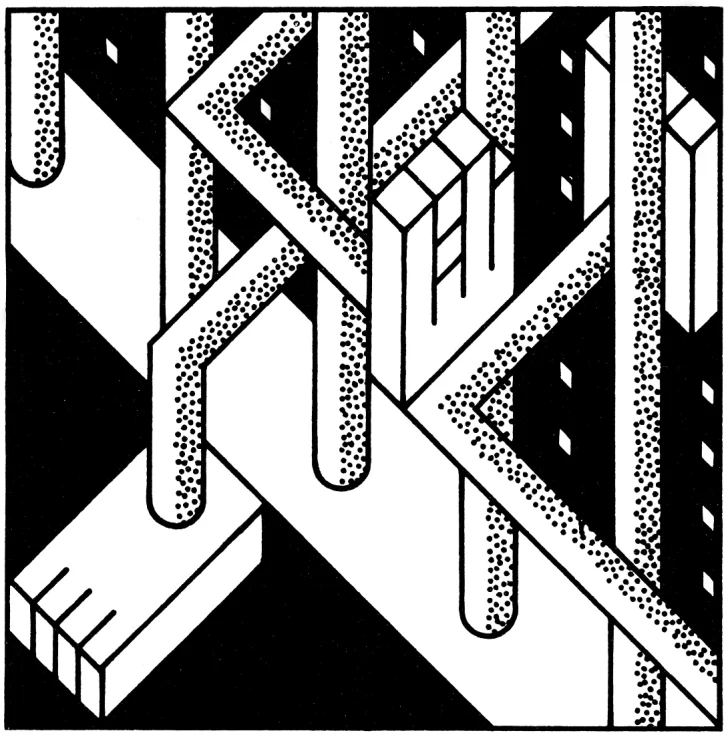
Rael remembers his first „erotic“ encounter with the other sex. Counting Out Time is a hilarious song. (Male) Listeners may perhaps suppress a smile – who can claim to have been so accomplished at theirfirst time? – but the idea of having sex “painting by numbers” fashion is delightfully absurd. Counting Out Time runs its course in a regular rhythm, and without the peculiar part in the middle it could almost be a pop song. Many things have been read into the sotto voce line “Put it away Mr Guitar” (Peter asking Steve Hackett not to do something?); if one assumes that Rael has serenaded his partner the riddle dissolves into nothing. At the end of the song Rael is back alone in the production area where he discovers a corridor covered in lamb’s wool. The Carpet Crawlers is, next to Hairless Heart, the coziest song on the first record. With a regular beat it turns out a really catchy song and one to cuddle up with a loved one. And it is actually one of few songs on the album for which Peter Gabriel wrote the main melody, as Gabriel’s first wife Jill points out in Spencer Bright’s book.
Through the door at the end of the corridor he enters a room with 32 doors. Just one of those doors leads out, all others simply lead back into The Chamber Of 32 Doors. Many people assail him with their explanations which door he should take. Overwhelmed by all the suggestions Rael is once more thrown back on himself. With various rhythms and melodic elements The Chamber Of 32 Doors expresses Rael’s difficulty to make a choice – up to the desperate offer to give up all his dreams for a way out. Will he pick the right door?
This cliffhanger ends the first half of the story of Rael. The listener has time to ponder why the album is called The Lamb Lies Down On Broadway and not, for example, Rael And His Amazing Technicolor Morning Visions. Gabriel himself seems to have preempted any speculation about the deeper meaning of the animal (after all, the lamb has fixed connotations in the Christian sphere) in the accompanying story: “Meanwhile, from out of the steam, a lamb lies down. This lamb has nothing whatsoever to do with Rael or any other lamb – it just lies down on Broadway.” There is, however, enough room left for interpretation, but they will have to be postponed because by now the listener will have changed the CD or LP and is ready to enter the second half of the album.
The first being he encounters there is Lilywhite Lilith who leads him accompanied by smashing guitars out of the right door and into a large underground room where she leaves him alone. Lilith is actually an old acquaintance from the Genesis oeuvre: The central motive of the song stems from the song The Light from 1970/71 that can unfortunately be found only on a rather mediocre live recording. Rael’s fear grows into near panic in the darkness until two golden globes emitting a glaring light hover into the room. He destroys both with a stone’s throw, upon which the whole cave collapses. The fear and the appearing of the globes are presented marvelously in the instrumental The Waiting Room.

The development of The Waiting Room
Tony: “The best jam we had in the rehearsal room ended up being called The Waiting Room, which we called The Evil Jam. We switched off all the lights and just made noises. And the first time it was really frightening.” – Phil: “The Evil Jam started with Steve inventing noises and Tony messing around on a couple of synthesizers – we were just mucking about with some really nasty sounds. We were all getting very intense; Peter was blowing his oboe reeds into the microphone and playing his flute with the echoplex on when suddenly there was this great clap of thunder and it started raining. […] We were all making these weird noises when the thunderstorm started and it began to pour down. And then we all shifted gear and got into this really melodic mood.” [both quotes: Hugh Fielder, The Book Of Genesis, p. 91/92]
Buried under the rocks Rael sings his farewell song Anyway; it seems clear that he will not escape from that place. The song begins with a very even piano melody that sounds like a remote echo from the beginning of The Lamb Lies Down On Broadway. Rael considers his situation quite sarcastically and mocks himself for being “so profound when everything you are is dying underground”. Strong, big chords by the whole band introduce a brief guitar solo after which Rael narrates how he would have wanted to die. That very moment an (un)expected guest makes his appearance to dancing music: Disguised as the Supernatural Anaesthetist death visits Rael, who is very impressed by death’s ability to dance.
It seems that Rael survives this encounter and escapes from under the rocks. Again his way leads him down a corridor.
Surrounding by sweet fragrance Rael reaches a pool of rose water. After all the strains Rael is only too happy to enter the pool to refresh himself. He is not alone those. The Lamia appear, three snakes with female faces, and caress him, stroke and nibble on him. Their touches become increasingly urgent, and when they finally draw blood they die from it. Rael eats what is left of their bodies. The romantic-erotic episode is illustrated by a gentle piano; only when the Lamia appear so do the other instruments. The Lamia is probably the most romantic song of the whole album. At its end the mood breaks just like the colour changes in the last two verses of The Lamia from warm red tones to a cold blue.
At this point the musical action comes to a halt. Silent Sorrow In Empty Boats is a rather uninspired instrumental; guitar and bass repeat a slow, languorous sequence of notes while Tony Banks pastes broad chords over it on the keyboard that waver somewhere between ambient sounds and a choral.
The fourth side of the album begins with Rael’s arrival in the Colony Of Slippermen. The first part, Arrival, is another aimlessly meandering enossificated instrumental like Silent Sorrow; of course, these ninety seconds were necessary during the live shows to give Gabriel more time to change costumes, but just why the whole thing was included on the album remains the band’s secret. It may be debated whether Genesis permitted themselves the luxury to accommodate the studio album for the necessities of the live show. The Arrival ends and spirited music leads into the Colony Of Slippermen proper.
Idyllic scenes of Wordsworthian origin are immediately foiled by the approach of the Slippermen. They turn out to be Rael’s predecessors who abandoned themselves to the Lamia and therefore have turned into disgusting creatures totally disfigured by their lust. They also seem not to play the guitar; that instrument can hardly be heard on this song. Excellent how Gabriel conveys Rael’s horror at finding out that he himself has turned into a Slipperman, too. Gabriel uses different voices to present the Slippermen, Rael and Dr Dyper, who really sounds notorious. Rael encounters his brother John again. Together they undergo surgery to “make them human again”, i.e. castration. During the Visit To The Doctor the music becomes more and more urgent, driving, eases off briefly and then, like Rael, begins to hunt The Raven who stole the tube in which Rael’s “crown jewels” are stored. John remains behind, once more deserting his brother whose hunt has lead him to the top of a ravine. Ravine illustrates the cold wind that is blowing there and the great height from which Rael looks down at the tube. A very accomplished piece that today would certainly be put in the category of “ambient sounds”. The album could probably progress from The Colony Of Slippermen to The Light Dies Down On Broadway without any big musical loss, but the suspense of the story demands a retardation and Ravine does the trick very well.
From the first notes of The Light Dies Down On Broadway album and story strive inexorably towards the climax. Rael is given the opportunity to return to the “upper world”, back to Broadway. The familiar noises sound very seductive in his ears and in the listener’s ears, too, because the song is a gentler reprise of The Lamia in the verses and The Lamb Lies Down On Broadway in the chorus. This reprise had a big advantage when Genesis were writing the song: Gabriel was way behind schedule with the lyrics. He needed a song between The Colony Of Slippermen and Riding The Scree – and lyrics for it. With a reprise the band saved time so that they could focus on the lyrics. For this song it was not Gabriel who penned them but Banks and Rutherford who relieved Peter’s burden a bit.
Amidst the sirens’ call Rael hear his brother John calling for help from within the raging river below. Rael has to make the most difficult decision of his whole life: Should he return to the normal world or save his brother? He picks John. The illusion of Broadway vanishes. The music calms down a bit until Rael jumps down the scree head over heels – or full of bravado? He does compare himself to the famous stuntman Robert C. “Evil” Knievel – into the gorge to rescue his brother from the raging river Tony Banks makes almost visible with his swirling keyboard cascades.
The current quickly takes him to the point of decision: It is In The Rapids that Rael attempts to save John – and himself. It is the moment where Rael exceeds himself: He manages to pull his brother onto dry land, looks into his face – and sees his own. And that is It, then. In the final song the narrator explains what It is exactly. The music sounds light-hearted and lively as if it felt happy to have escaped from subterranean catacombs full of Slippermen, Lamia and dancing Grim Reapers. Those who hope to find out in the last song what this story is about get plenty answers –so many answers, in fact, that he, like Rael in The Chamber Of 32 Doors, is at a loss which one to choose. It is not pretentious but real and Rael at the same time. Peter Gabriel sums it up nicely in the story that accompanies the music: It is up to you.

All in all…
Many things about this album are remarkable. The music, for example, which is ethereal at times and groovy at others, or the very polished lyrics. One thing that is remarkable though less obvious is the careful way the story has been structured and distributed across the four sides of two vinyl records. The first song on each side presents Rael from different points of view: The Lamb Lies Down On Broadway shows him in his natural habitat. Back In N.Y.C.Rael presents himself as he sees himself. Lilywhite Lilith shows him in contact with others and facing his own fears – the very fears he has discarded when he fearlessly undergoes surgery in The Colony Of Slippermen. From the huge number of options Rael has to pick one door at the end of the first record while at the end of the second record the listener is given – count for yourselves! – 32 different descriptions for It.
The Lamb Lies Down On Broadway is quite a cohesive though quite bizarre story. As a work of music it is less monolithic: Excellent songs like In The Cage, The Chamber Of 32 Doors and The Lamia sit next to less flamboyant quality pieces like Cuckoo Cocoon and In The Rapids. At the other end of the spectrum one finds material like Silent Sorrow In Empty Boats that sticks out from the rest of the album. The reviewer cannot help but think that the band ran out of ideas slighty after the half-way point, so they took some songs to catch their breath before they – say, from The Light Dies Down On Broadway onwards – drew motivation from the prospect of almost being through with the album and wrote another couple of great songs.

The Lamb Lies Down On Broadway is a massive monolith among the works of Genesis. It is their only studio double album (if you consider the normal playtime of the dominant medium at the time the album in question was released, i.e. LP or CD). It is their only concept album, at the same time the last release with Peter Gabriel and the only album that was played in full on the accompanying tour. One cannot really compare mood and music of The Lamb with the albums that were released before or after it. It has already been mentioned that some describe this album as Genesis’ “most American”; in fact, one is tempted to see Peter Gabriel’s second solo album prefigured in the rather cold sounds. Without any doubt this Genesis album marks far more than the end of the classic five-piece line-up of messieurs Banks, Collins, Gabriel, Hackett and Rutherford: The Lamb Lies Down On Broadway is, despite its little flaws, the culmination of the Gabriel years. Is it all just “knock and know-all”? Maybe – but it is nevertheless a masterpiece.
by Martin Klinkhardt
A Super Deluxe Edition Boxset of the album has been announced for a 28 March 2025 release. All info can be found here.


